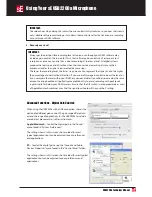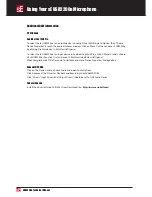
USB2200a Technical Manual
SE Electronics Microphone Manual
Thank you for purchasing this SE Electronics microphone, which was hand built in one of the most
advanced microphone manufacturing facilities in China. Designed by a team of extremely experienced
engineers and verified by extensive listening tests. Each model utilises gold sputtered, ultra-light mylar
diaphragms in an advanced capsule design. Your microphone was constructed using the finest quality
Japanese electronic components and extensively tested to provide you with years of trouble-free
operation.
* Note: The USB2200a will lock to 88.2 and 96 K clocks on most software, writing files as 16 bit and, with
the automatic conversion (bit stuffing), 24 bit files. Therefore users who have sessions at different rates
and want to use the mic, in most cases, can.
Pickup Patterns
There are two basic microphone directional patterns, omnidirectional, which picks up sound
equally from all directions and figure-of-eight, which picks up from both the front and rear of
the microphone but not from the sides. Combining these two basic patterns creates a cardioid
or directional response, which simply means the microphone is most sensitive in one particular
direction. By varying the way in which the omnidirectional and figure-of-eight patterns are
combined, varying widths of cardioid pattern can be created.
Cardioid
The USB2200a microphone utilises a Cardioid polar pattern. Cardioid pattern microphones are
popular for general-purpose recording as they can be directed at the wanted sound source while
offering a measure of rejection to sounds approaching the microphone from the rear, and to a
lesser extent, the sides. This is the polar pattern of the USB2200a.
Where several musicians are playing together, this reduces the amount of crosstalk between the
microphones. Cardioid pattern microphones also pick up less of the ‘room sound’, which results
in a clearer, less ‘coloured’ recording. Note that cardioid microphones belong to the category of
‘pressure gradient’ microphone as their output signal depends on the differences in air pressure
between the front and rear of the capsule.
All pressure gradient microphones exhibit some degree of proximity effect, which simply means
that there is a significant rise in their bass response if they are used very close to the sound
source. If desired this can be countered by using the low-cut switch on the microphone or
microphone preamplifier.
Technical parameters:
1.
USB 2.0 USB1.x compatible
2.
Stereo D/A and A/D conversion
3.
Zero latency Headphone monitoring
4.
Gain Control built in
5.
At THD > -90db, SNR 96db (D/A conversion)
6.
At THD > -90db, SNR 92db (A/D conversion)
7.
Adaptive 44.1 to 48KHz sampling frequency
Technical Specifications - USB2200A
Frequency Response:
20Hz-20KHz
Sensitivity:
14.1mV/Pa -37 ± 1.5dB
Polar Pattern:
Cardioid
Impedance:
≤ 150 Ohms
Equivalent Noise Level:
12dB(A weighted)
Max SPL for 0.5% THD@1000Hz:
130dB
Power Requirement:
Phantom power 48V±4V or USB
Connector:
3-pin
Содержание USB2200a
Страница 1: ...Electronics USB2200a Microphone Manual ...
Страница 2: ...USB2200a Technical Manual ...
Страница 11: ...www seelectronics com Electronics ...





























